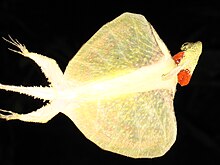Draco norvillii
| Draco norvillii | |
|---|---|

| |
| Scientific classification | |
| Domain: | Eukaryota |
| Kingdom: | Animalia |
| Phylum: | Chordata |
| Class: | Reptilia |
| Order: | Squamata |
| Suborder: | Iguania |
| Family: | Agamidae |
| Genus: | Draco |
| Species: | D. norvillii
|
| Binomial name | |
| Draco norvillii Alcock, 1895
| |
Draco norvillii, also known as Norvill's flying lizard, is species of agamid flying lizard endemic to India.[1] This species is capable of gliding from tree to tree, and has been recorded gliding up to 50 metres (160 ft). It feeds on insects and other small invertebrates.
Etymology
[edit]The specific name, norvillii, is in honor F.H. Norville who was the collector of the holotype.[2]
Taxonomy
[edit]Musters (1983) examined specimens of D. norvillii but was not able to examine the type. He opines that this lizard is a subspecies of Draco blanfordii.[3] This view has not been endorsed in McGuire & Heang's (2001) study on the phylogenetic systematics of Southeast Asian flying lizards (Iguania: Agamidae: Draco).[4]
Geographic range
[edit]Draco norvillii has been recorded from Assam, Nagaland, and Arunachal Pradesh in NE India.[1] A rare and endangered species of lizard, it was described by Alcock and named after the collector of the type (F. H. Norvill) of Doom Dooma, Upper Assam (now Arunachal Pradesh). The type locality may be considered restricted to "North-eastern India, possibly Doom Dooma (27.57°N 95.57°E), Arunachal Pradesh, northeastern India".
D. norvillii was recently rediscovered after 118 years in the Jeypore Reserve Forest by Mazedul Islam and Professor Prasanta Kumar Saikia of the Animal Ecology and Wildlife Biology Laboratory of the Zoology Department, Gauhati University in 2012. Two lizards were recorded.[5]
Description
[edit]Two individuals of D. norvillii, a female and juvenile, were encountered in Jeypore Reserve Forest in 2012 during a survey by biologists from Gauhati University.[6]
Islam & Saikia describe the specimens as follows :[6]
- Head: Broader than its length. Tympanum partially scaled over. The nostrils are inclined towards the vertical. Nine supralabial scales.
- Body: Grayish above. Middle portion of dorsal part barred with light transverse lines. The neck and head regions were with greenish markings. The tail was with alternate white and black bands.
- Throat: The base of the gular pouch was scarlet in colour. Gular appendage of female is yellow in colour and shorter than the head in length.
- Patagium: Female - lower half red. Upper half black. Stippled with white and yellow broken lines and spots. Supported by 5 ribs on each side. Greyish upper side and orange lower half in juveniles.
- Belly: Yellow. No caudal crest present. Tail denticulated towards latter side.
- Hind limbs: Possessing thorny scutes.
- Measurements :
- Length Snout to Vent: 68 mm (2.7 in)
- Length Tail: 124 mm (4.9 in)
- Distance between the armpit to groin: 34 mm (1.3 in)
References
[edit]- ^ a b Draco norvillii at the Reptarium.cz Reptile Database. Accessed 27 June 2016.
- ^ Beolens, Bo; Watkins, Michael; Grayson, Michael (2011). The Eponym Dictionary of Reptiles. Baltimore: Johns Hopkins University Press. xiii + 296 pp. ISBN 978-1-4214-0135-5. (Draco norvillii, p. 191).
- ^ Muster CJM. (1983). "Taxonomy of the genus Draco L. (Agamidae, Lacertilia, Reptilia)". Zoologische Verhandelingen (199). E.J. Brill, Leiden: 17–19. Retrieved 27 April 2013.
- ^ McGuire, Jimmy A.; Heang, Kiew Bong. (2001). "Phylogenetic systematics of Southeast Asian flying lizards (Iguania: Agamidae: Draco) as inferred from mitochondrial DNA sequence data" (PDF). Biological Journal of the Linnean Society. 72 (2): 203–229. doi:10.1006/bijl.2000.0487. Retrieved 27 April 2013.
- ^ Patowary, Ajit. (18 April 2013). "Flying lizard rediscovered in State after 118 years". The Assam Tribune. Archived from the original on 10 January 2014. Retrieved 28 April 2013.
- ^ a b Islam, Mazedul; Saikia, Prasanta Kumar. (2013). "Inventory and Natural History of Lizards in Jeypore Reserve Forest, Assam" (PDF). Reptile Rap: Newsletter of the South Asian Reptile Network. 15 (January 2013). South Asian Reptile Network: 16–26. ISSN 2230-7079. Retrieved 27 April 2013.
Further reading
[edit]- Alcock A. (1895). "On a New Species of Flying Lizard from Assam". J. Asiatic Soc. Bengal 64 (1): 14–15. (Draco norvillii, new species).
